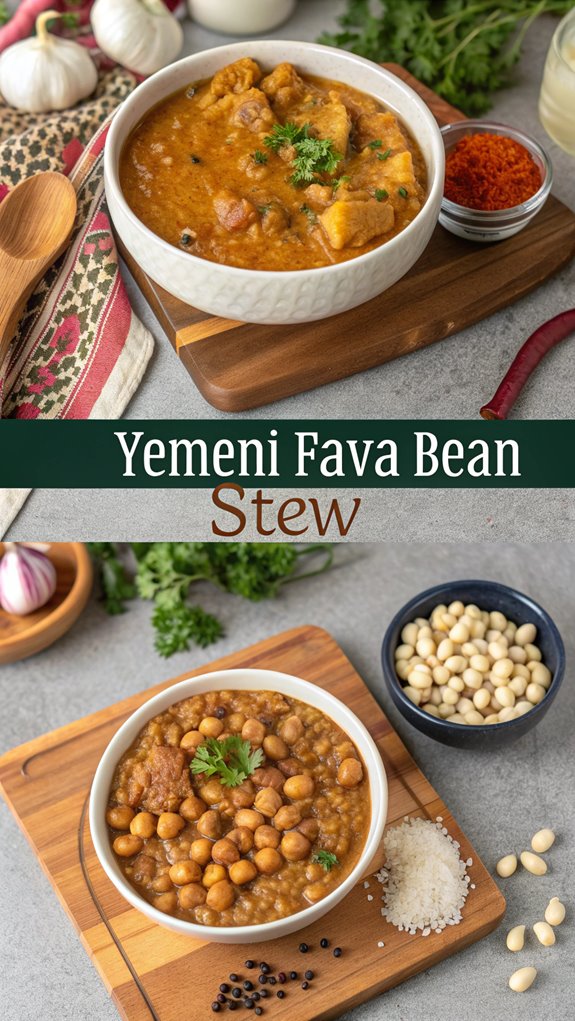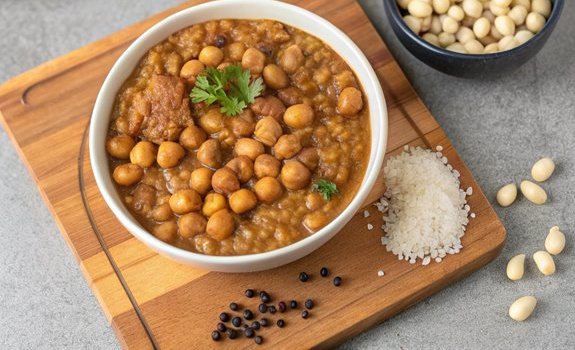Yemeni Recipe
A great Yemeni recipe to try is Foul, a comforting fava bean stew. You’ll need a few ingredients: olive oil, red onion, garlic, roma tomatoes, canned fava beans, salt, cumin, and black pepper. Start by heating the olive oil in a pot, adding the diced onion until it’s translucent. Then, mix in minced garlic, chopped tomatoes, and the fava beans with spices. Let it simmer for 10-15 minutes, and finish with chopped herbs. Serve it warm with flatbread. This dish reflects Yemen’s rich culinary history, and there’s much more to explore about its unique flavors and significance.
Key Takeaways
- Yemeni cuisine features rich flavors from aromatic spices like cumin, coriander, and cinnamon, essential for authentic recipes.
- A popular dish, Saltah, represents Yemen’s culinary heritage and is often enjoyed during communal dining.
- Fava Bean Stew (Foul) is a beloved, easily customizable dish, typically made with canned fava beans and fresh ingredients.
- Traditional Yemeni dishes emphasize hospitality and are often shared among family and friends during gatherings.
- Yemeni cuisine is gaining global recognition while maintaining its traditional essence, showcasing ancient trade influences.
Why You’ll Love this Recipe
When you dive into Yemeni cuisine, you’ll discover a rich tradition steeped in history and cultural significance. This culinary world offers unique flavors, thanks to its aromatic spices like cumin, coriander, and cinnamon. The national dish, Saltah, showcases these spice blends and represents Yemen’s heritage. Yemeni cuisine’s emphasis on communal dining makes each meal an opportunity to connect and share with loved ones.
Yemeni meals, such as Aseed, aren’t just about food; they symbolize community and unity, often enjoyed during gatherings and celebrations. Cooking traditional dishes is an art form that preserves this cultural heritage across generations. The diverse influences from eastern Africa and South Asia further enrich Yemeni flavors.
Recipe

Yemeni Fava Bean Stew (Foul)
Yemeni Fava Bean Stew, known as Foul, is a beloved dish that combines rich flavors from fresh ingredients and spices, creating a hearty and satisfying meal. This dish is traditionally made with canned fava beans, allowing for quick preparation while still delivering a punch of flavor. The addition of garlic, tomatoes, and spices results in a deliciously aromatic stew that’s perfect for any time of day. Served with warm flatbread, it’s a staple in Yemeni cuisine that brings comfort and nourishment. This stew is similar to the Ten-Minute Dough method in that it emphasizes quick preparation without sacrificing quality.
This stew can be easily customized to your taste preferences by adjusting the level of heat with jalapeños and spices. The use of fresh herbs like cilantro or parsley adds a refreshing touch that complements the dish beautifully.
Whether enjoyed for breakfast, lunch, or dinner, Yemeni Fava Bean Stew is a delightful way to experience the rich culinary traditions of Yemen.
Ingredients:
- 3 tablespoons extra virgin olive oil
- ½ large red onion
- 3 garlic cloves
- Whole jalapeño or to taste
- 2 large roma tomatoes
- 1 ½ tablespoons tomato paste
- ¼ cup chopped cilantro or parsley
- Canned fava beans with liquid
- ½ teaspoon salt
- ½ teaspoon cumin
- ½ teaspoon black pepper
- ⅓ cup hot water
Cooking Instructions:
- Begin by heating the olive oil in a large pot over medium heat. Add the diced red onion and sauté until it becomes translucent, which should take about 5 minutes.
- Stir in the minced garlic and sliced jalapeño, cooking for an additional minute until fragrant.
- Chop the roma tomatoes and add them to the pot, cooking until they soften, approximately 3-4 minutes. Stir in the tomato paste and cook for another minute, allowing the flavors to meld.
- Next, add the canned fava beans with their liquid, along with the salt, cumin, black pepper, and hot water. Stir everything together and bring the mixture to a gentle simmer.
- Let it cook for about 10-15 minutes, allowing the flavors to develop and the stew to thicken.
- Once cooked, stir in the chopped cilantro or parsley. Taste and adjust seasoning if necessary. Serve the stew hot, accompanied by warm flatbread for dipping.
Extra Tips:
When cooking Yemeni Fava Bean Stew, feel free to experiment with different spices or add more vegetables based on your preference.
If you enjoy a spicier dish, increase the amount of jalapeño or add chili flakes. To make it even heartier, consider incorporating diced potatoes or carrots.
This dish can also be prepared in larger batches and stored in the refrigerator for up to three days, making it a convenient meal option throughout the week. Enjoy your cooking!
Final Thoughts
Yemeni cuisine offers a rich tapestry of flavors and traditions that can deeply connect you to the culture’s history and communal values.
When you explore this cuisine, you’re not just tasting food; you’re experiencing centuries of influence and heritage.
Here are some key points to remember:
- Cultural Significance: Food unites families and friends during gatherings.
- Historical Roots: Dishes reflect Yemen’s ancient trade routes and foul Yemeni’s recognition as one of the oldest dishes in the region.
- Community: Sharing meals showcases hospitality and generosity.
- Modern Influence: Yemeni cuisine is gaining global recognition, adapting traditional recipes while preserving their essence.
- Flavor Characteristics: Expect bold spices like cumin and coriander, often enhanced through slow cooking.
Frequently Asked Questions
What Are Common Spices Used in Yemeni Cuisine?
In every culture’s spice cabinet, you’d find treasures like cumin, turmeric, and cardamom. In Yemeni cuisine, these spices create warmth and depth, transforming simple dishes into aromatic experiences that celebrate centuries of culinary tradition.
Can I Substitute Ingredients in This Yemeni Recipe?
Absolutely, you can substitute ingredients! Just keep the essence of the dish in mind. Experiment with different proteins or spices based on your taste, and feel free to adjust vegetables for a personal touch.
How Can I Store Leftovers From This Recipe?
You can store leftovers in airtight containers. Refrigerate them for up to three days or freeze for up to three months. When reheating, do it gently on the stovetop or in the microwave.
Are There Vegetarian Options in Yemeni Cooking?
When it comes to vegetarian options, you’ll find a treasure trove of flavors waiting for you. Dishes like vegetable mandi and spiced lentil rice burst with spices, making every bite a delightful journey for your taste buds.
What Traditional Dishes Pair Well With This Recipe?
When considering traditional dishes that pair well, think of options like Foul with flatbread, or Saltah alongside rice. Mandi and Khubz complement various meals, enhancing flavors and creating a satisfying dining experience. Enjoy mixing them!



